Notes: Great Victoria Street was the Great Northern Railway of Ireland (GNRI) terminus in the city of Belfast. The GNRI had the second largest railway system on the island of Ireland and part of its network was the main line that linked the cities of Belfast and Dublin. Belfast Great Victoria Street had opened on 12 August 1839 as the northern terminus of the 7½-mile Ulster Railway (UR) which connected the city to Lisburn. A through route to Dublin was only created when the Dublin & Belfast Junction Railway (D&BJR) opened the final section of its line, a bridge over the river Boyne at Drogheda 5 April 1855 (although a temporary wooden bridge had been in situ during 1853 for the Dublin International Exhibition).
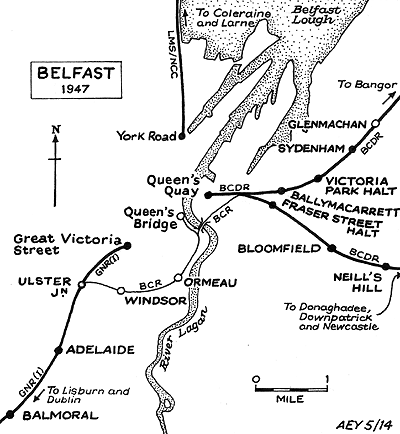 Belfast Great Victoria Street was located on the west side of the street from which it took its name and at the time of its opening it was known simply as Belfast. The station was a fine sturdy building that had two platforms and three tracks. The exterior was classical in influence, with its main two-storey block linked to shorter two-storey wings by single-storey sections. The ground floor stonework was rusticated and windows were rectangular with elaborate architraves. The upper storeys had round-headed windows with hoods. The central block was topped by a balustrade. The entrance to the main block was projected forward and was also topped by a balustrade and had pairs of impressive columns. A generous porte-cochère stood in front of the central block. Belfast Great Victoria Street was located on the west side of the street from which it took its name and at the time of its opening it was known simply as Belfast. The station was a fine sturdy building that had two platforms and three tracks. The exterior was classical in influence, with its main two-storey block linked to shorter two-storey wings by single-storey sections. The ground floor stonework was rusticated and windows were rectangular with elaborate architraves. The upper storeys had round-headed windows with hoods. The central block was topped by a balustrade. The entrance to the main block was projected forward and was also topped by a balustrade and had pairs of impressive columns. A generous porte-cochère stood in front of the central block.
The track gauge of the UR was 6ft 2in.
At the time of opening there were seven services in each direction between Belfast and Lisburn and on the first day of service 3,000 people were carried. In the early years there were no third class coaches on the UR.
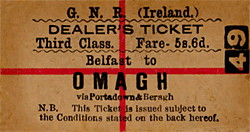 The UR reached Portadown in 1842. At the same time the Dublin & Drogheda Railway (D&DR) started to build their line using a gauge of 5ft 2in which caused consternation amongst the board of the UR who saw that line as a means of creating a link to Dublin. Major General Pasley RE was called in to arbitrate and he came up with a compromise of 5ft 3in which became the standard gauge for the island of Ireland. The UR had to re-gauge their line at a cost of £20,000. The UR reached Portadown in 1842. At the same time the Dublin & Drogheda Railway (D&DR) started to build their line using a gauge of 5ft 2in which caused consternation amongst the board of the UR who saw that line as a means of creating a link to Dublin. Major General Pasley RE was called in to arbitrate and he came up with a compromise of 5ft 3in which became the standard gauge for the island of Ireland. The UR had to re-gauge their line at a cost of £20,000.
In 1848 the UR reached Armagh.
The March 1850 timetable showed 7 departures and 8 arrivals Mondays-to-Saturdays and 3 trains in each direction on Sundays.
In 1852 the UR renamed the station Victoria Street as, by that time, two other railway companies had opened termini in the city. The station was renamed Great Victoria Street in 1856 by which time through services were running to Dublin. By 1858 the UR was able to run services to Londonderry.
Originally there had been a level crossing at the west end of the station but it was replaced with a bridge, named the Boyne bridge, in 1863.
In 1875 the D&DR and the D&BJR merged to form the Northern Railway of Ireland. A year later the UR agreed to merge and the company became the Great Northern Railway Company Ireland (GNRI).
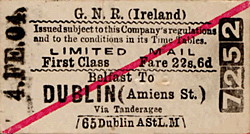 By the 1880s the station had been expanded to six platform faces which were protected from the elements by a trainshed roof. Some of the platforms extended to the south side of the Boyne Court bridge. The GNRI network had also expanded by this time and served many locations including Bundoran, Cavan, Cookstown and Newcastle. By the 1880s the station had been expanded to six platform faces which were protected from the elements by a trainshed roof. Some of the platforms extended to the south side of the Boyne Court bridge. The GNRI network had also expanded by this time and served many locations including Bundoran, Cavan, Cookstown and Newcastle.
The December 1895 timetable showed 32 departrures from Great Victoria Street on weekdays serving destinations including Armargh, Clones, Dublin, Drogheda, Londonderry Lisburn and Omagh.
In the period running up to the Great War the GNRI had its most profitable years. Many long distance trains that ran from Great Victoria Street had restaurant cars and there were even sleeping car services to Dublin Amiens Street and Londonderry Foyle Road.
The outbreak of war in August 1914 initially brought additional traffic to Great Victoria Street and to the GNRI network generally but within a few years shortages caused problems as did rising wage bills. The Easter Rising in 1916 caused additional problems as sections of the GNRI were targeted and services disrupted. The main line to Dublin was blown up at Fairview. In Ireland the Great War was followed by the war of independence and the Irish Civil War both of which brought even further disruption to the GNRI.
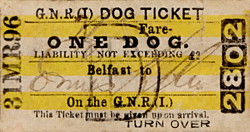 The outcome of the Irish War of Independence was the forming in 1921 of the Irish Free State. The Northern Counties, which included Belfast, had resisted becoming part of an independent Ireland and they became Northern Ireland. Belfast became the capital and the GNRI was paid £670,000 in compensation for the damage it had suffered. The outcome of the Irish War of Independence was the forming in 1921 of the Irish Free State. The Northern Counties, which included Belfast, had resisted becoming part of an independent Ireland and they became Northern Ireland. Belfast became the capital and the GNRI was paid £670,000 in compensation for the damage it had suffered.
A civil war erupted in the Free State which brought more disruption to the GNRI, and when peace finally came in 1923 it had the additional complication of being a railway company whose network was located in two separate countries. Trains that crossed the border were subject to customs checks which slowed them down.
The 1930s were difficult years for the GNRI which recorded its first financial loss in 1933. In 1936 the Boyne bridge at the west end of the station was rebuilt.
The Second World War brought an increase in traffic despite travel restrictions being imposed in the north. Northern Ireland, as part of the UK, was a combatant country whilst the Free State (by then Ireland and later the Republic of Ireland) was neutral. Many northerners travelled from Belfast to Dublin to escape for a period the rationing and the bombing that took place in 1941.
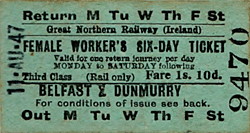 In 1947 the GNRI introduced ‘The Enterprise Express’, an express train that ran non-stop between Belfast Great Victoria Street and Dublin Amiens Street (later, Connolly) in under 2 hours. The first 'Enterprise' departed from Great Victoria Street at 10.30am on 11 August 1947. The service was operated by the GNRIs largest locomotives and its most modern coaches. Agreement had reached which allowed the Belfast – Dublin expresses to have the customs checks done at Great Victoria Street (and at the Dublin end at Amiens Street) but they could not stop en route. In 1947 the GNRI introduced ‘The Enterprise Express’, an express train that ran non-stop between Belfast Great Victoria Street and Dublin Amiens Street (later, Connolly) in under 2 hours. The first 'Enterprise' departed from Great Victoria Street at 10.30am on 11 August 1947. The service was operated by the GNRIs largest locomotives and its most modern coaches. Agreement had reached which allowed the Belfast – Dublin expresses to have the customs checks done at Great Victoria Street (and at the Dublin end at Amiens Street) but they could not stop en route.
On 1 January 1948 the railways of Northern Ireland, with the exception of the GNRI, were nationalised as part of the British Transport Commission and on 1 April 1949 they became part of the Ulster Transport Authority (UTA).
In 1950 Republic of Ireland nationalised its railways under the banner (CIE) which had been created in 1944 as a private company. As the GNRI network extended into another country it was excluded from the nationalisation.
However the GNRI was not in good shape and on 6 December 1950 it announced its intention to close its entire network. Both governments intervened and made good the losses.
On 1 January 1951 the GNRI abolished second class on all of its trains.
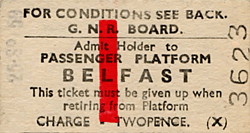 On 1 September 1953 the GNRI came to an end as an independent company. It was replaced with a joint concern of the two states called the Great Northern Railway Board. In the north there was a decidedly anti-rail bias which was particularly prevalent in the UTA. Three years after the forming of the joint board the Northern Ireland authorities announced that they intended to close much of the former GNRI system. The Dublin government protested and arguments followed which saw the abolition of the joint board on 1 October 1958. The assets of the board were divided between CIE and UTA with Great Victoria Street becoming a UTA station. On 1 September 1953 the GNRI came to an end as an independent company. It was replaced with a joint concern of the two states called the Great Northern Railway Board. In the north there was a decidedly anti-rail bias which was particularly prevalent in the UTA. Three years after the forming of the joint board the Northern Ireland authorities announced that they intended to close much of the former GNRI system. The Dublin government protested and arguments followed which saw the abolition of the joint board on 1 October 1958. The assets of the board were divided between CIE and UTA with Great Victoria Street becoming a UTA station.
The UTA had closed over three quarters of the lines that it had assumed responsibility for in 1950. As soon as the GNRI network within the province came into its ownership the closures began in earnest (some lines had actually closed in 1957).
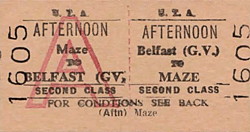 By the beginning of 1965 Great Victoria Street had only the Londonderry and Dublin lines left on which passenger services operated. The Londonderry line closed on 15 February 1965. A large part of the station was taken out of rail use and became a bus station. Only two platforms remained in use. By the beginning of 1965 Great Victoria Street had only the Londonderry and Dublin lines left on which passenger services operated. The Londonderry line closed on 15 February 1965. A large part of the station was taken out of rail use and became a bus station. Only two platforms remained in use.
On 5 April 1968 the UTA was dissolved and Great Victoria Street became part of Northern Ireland Railways (NIR).
During the early 1970s Great Victoria Street was bombed by the IRA on several occasions causing extensive damage that ultimately led to the demolition of the 1848 terminus building.
NIR was much more pro-rail and it resurrected plans for linking the lines that served Belfast. The first work authorised was the connecting of the former Belfast & County Down Railway with the GNRI line via the former Belfast Central Railway that had not seen a passenger train since 1885. A new station, Belfast Central, formed part of the works which saw their first trains on 12 April 1976. Great Victoria Street closed twelve days later on 24 April 1976.
After closure the remaining platforms were infilled and became part of the bus station.
In the 1990 the trainshed was demolished and the site was eventually developed with the Great Northern building.
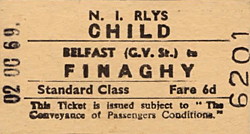 On 28 November 1994 the NIR plan to link all of the Belfast lines became a reality with the opening of the cross harbour line that created a link to the former Northern Counties Committee railway. NIR had created the most integrated railway network that Belfast had ever had. However Belfast Central was not, as its name would suggest, in a central part of Belfast and passengers complained about the fact. Great Victoria Street had been right in the heart of the city, and plans were drawn up for a new station on the original alignment of the railway to the south of the Boyne Court bridge (the original station having been on the north side). The plans also allowed for a new section of railway that would enable trains to run directly between Great Victoria Street and Central. The new line and station opened on 30 September 1995. On 28 November 1994 the NIR plan to link all of the Belfast lines became a reality with the opening of the cross harbour line that created a link to the former Northern Counties Committee railway. NIR had created the most integrated railway network that Belfast had ever had. However Belfast Central was not, as its name would suggest, in a central part of Belfast and passengers complained about the fact. Great Victoria Street had been right in the heart of the city, and plans were drawn up for a new station on the original alignment of the railway to the south of the Boyne Court bridge (the original station having been on the north side). The plans also allowed for a new section of railway that would enable trains to run directly between Great Victoria Street and Central. The new line and station opened on 30 September 1995.
Tickets from Michael Stewart and route map by Alan Young
Sources:
- Bradshaws July 1922 Railway Guide, Guild Publishing
- One Hundred & Fifty Years of Irish Railways, Fergus Mullighan, Appletree Press 1983
- Railways in Ireland Part Two, Martain Bairstow, 2007
- The Great Northern Railway - an Irish Railway Pictorial, Tom Ferris, Midland Publishing, 2003.
To see photos of the 1995 Great Victoria Street click here
|

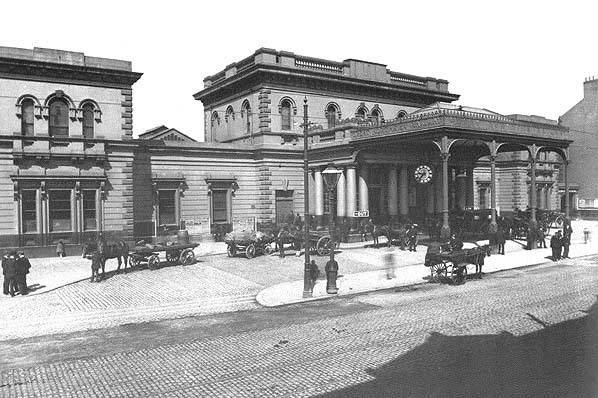
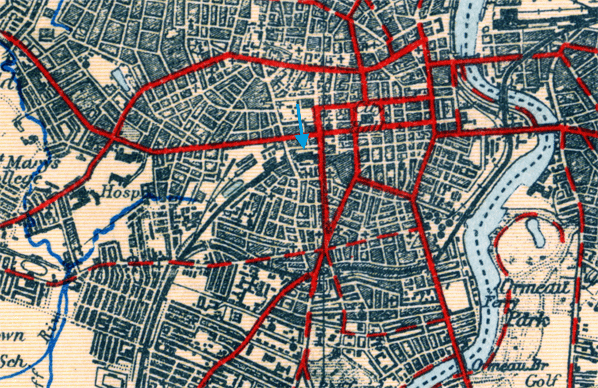
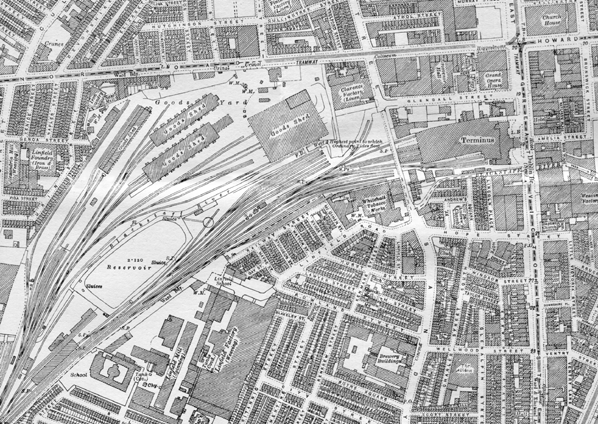
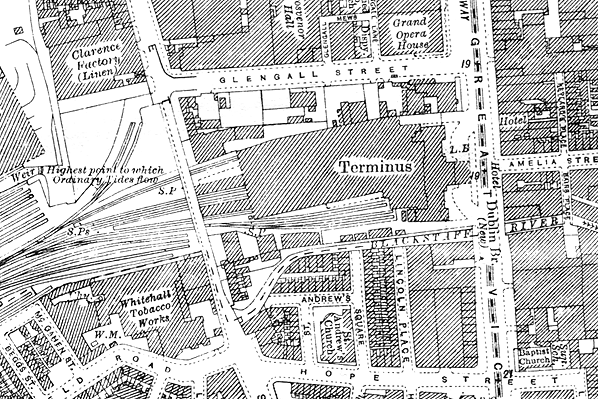
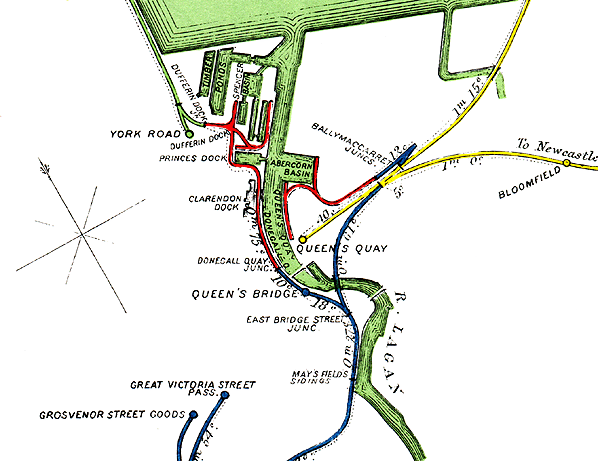
.jpg)
.jpg)
.jpg)
1.jpg)
4.jpg)
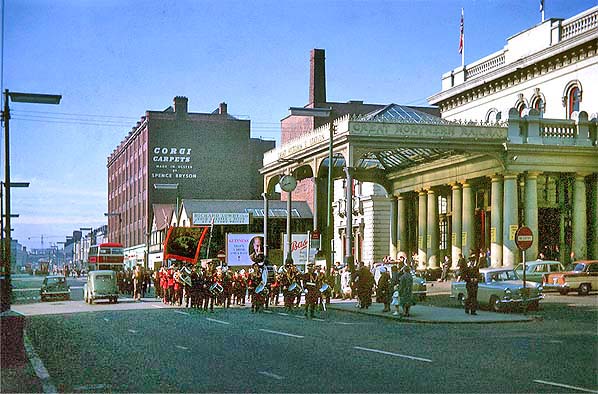
.jpg)
 Belfast Great Victoria Street was located on the west side of the street from which it took its name and at the time of its opening it was known simply as Belfast. The station was a fine sturdy building that had two platforms and three tracks. The exterior was classical in influence, with its main two-storey block linked to shorter two-storey wings by single-storey sections. The ground floor stonework was rusticated and windows were rectangular with elaborate architraves. The upper storeys had round-headed windows with hoods. The central block was topped by a balustrade. The entrance to the main block was projected forward and was also topped by a balustrade and had pairs of impressive columns. A generous porte-cochère stood in front of the central block.
Belfast Great Victoria Street was located on the west side of the street from which it took its name and at the time of its opening it was known simply as Belfast. The station was a fine sturdy building that had two platforms and three tracks. The exterior was classical in influence, with its main two-storey block linked to shorter two-storey wings by single-storey sections. The ground floor stonework was rusticated and windows were rectangular with elaborate architraves. The upper storeys had round-headed windows with hoods. The central block was topped by a balustrade. The entrance to the main block was projected forward and was also topped by a balustrade and had pairs of impressive columns. A generous porte-cochère stood in front of the central block. The UR reached Portadown in 1842. At the same time the Dublin & Drogheda Railway (D&DR) started to build their line using a gauge of 5ft 2in which caused consternation amongst the board of the UR who saw that line as a means of creating a link to Dublin. Major General Pasley RE was called in to arbitrate and he came up with a compromise of 5ft 3in which became the standard gauge for the island of Ireland. The UR had to re-gauge their line at a cost of £20,000.
The UR reached Portadown in 1842. At the same time the Dublin & Drogheda Railway (D&DR) started to build their line using a gauge of 5ft 2in which caused consternation amongst the board of the UR who saw that line as a means of creating a link to Dublin. Major General Pasley RE was called in to arbitrate and he came up with a compromise of 5ft 3in which became the standard gauge for the island of Ireland. The UR had to re-gauge their line at a cost of £20,000.  By the 1880s the station had been expanded to six platform faces which were protected from the elements by a trainshed roof. Some of the platforms extended to the south side of the Boyne Court bridge. The GNRI network had also expanded by this time and served many locations including Bundoran, Cavan, Cookstown and Newcastle.
By the 1880s the station had been expanded to six platform faces which were protected from the elements by a trainshed roof. Some of the platforms extended to the south side of the Boyne Court bridge. The GNRI network had also expanded by this time and served many locations including Bundoran, Cavan, Cookstown and Newcastle. The outcome of the Irish War of Independence was the forming in 1921 of the Irish Free State. The Northern Counties, which included Belfast, had resisted becoming part of an independent Ireland and they became Northern Ireland. Belfast became the capital and the GNRI was paid £670,000 in compensation for the damage it had suffered.
The outcome of the Irish War of Independence was the forming in 1921 of the Irish Free State. The Northern Counties, which included Belfast, had resisted becoming part of an independent Ireland and they became Northern Ireland. Belfast became the capital and the GNRI was paid £670,000 in compensation for the damage it had suffered.  In 1947 the GNRI introduced ‘The Enterprise Express’, an express train that ran non-stop between Belfast Great Victoria Street and Dublin Amiens Street (later, Connolly) in under 2 hours. The first 'Enterprise' departed from Great Victoria Street at 10.30am on 11 August 1947. The service was operated by the GNRIs largest locomotives and its most modern coaches. Agreement had reached which allowed the Belfast – Dublin expresses to have the customs checks done at Great Victoria Street (and at the Dublin end at Amiens Street) but they could not stop en route.
In 1947 the GNRI introduced ‘The Enterprise Express’, an express train that ran non-stop between Belfast Great Victoria Street and Dublin Amiens Street (later, Connolly) in under 2 hours. The first 'Enterprise' departed from Great Victoria Street at 10.30am on 11 August 1947. The service was operated by the GNRIs largest locomotives and its most modern coaches. Agreement had reached which allowed the Belfast – Dublin expresses to have the customs checks done at Great Victoria Street (and at the Dublin end at Amiens Street) but they could not stop en route.  On 1 September 1953 the GNRI came to an end as an independent company. It was replaced with a joint concern of the two states called the Great Northern Railway Board. In the north there was a decidedly anti-rail bias which was particularly prevalent in the UTA. Three years after the forming of the joint board the Northern Ireland authorities announced that they intended to close much of the former GNRI system. The Dublin government protested and arguments followed which saw the abolition of the joint board on 1 October 1958. The assets of the board were divided between CIE and UTA with Great Victoria Street becoming a UTA station.
On 1 September 1953 the GNRI came to an end as an independent company. It was replaced with a joint concern of the two states called the Great Northern Railway Board. In the north there was a decidedly anti-rail bias which was particularly prevalent in the UTA. Three years after the forming of the joint board the Northern Ireland authorities announced that they intended to close much of the former GNRI system. The Dublin government protested and arguments followed which saw the abolition of the joint board on 1 October 1958. The assets of the board were divided between CIE and UTA with Great Victoria Street becoming a UTA station.  By the beginning of 1965 Great Victoria Street had only the Londonderry and Dublin lines left on which passenger services operated. The Londonderry line closed on 15 February 1965. A large part of the station was taken out of rail use and became a bus station. Only two platforms remained in use.
By the beginning of 1965 Great Victoria Street had only the Londonderry and Dublin lines left on which passenger services operated. The Londonderry line closed on 15 February 1965. A large part of the station was taken out of rail use and became a bus station. Only two platforms remained in use. On 28 November 1994 the NIR plan to link all of the Belfast lines became a reality with the opening of the cross harbour line that created a link to the former Northern Counties Committee railway. NIR had created the most integrated railway network that Belfast had ever had. However Belfast Central was not, as its name would suggest, in a central part of Belfast and passengers complained about the fact. Great Victoria Street had been right in the heart of the city, and plans were drawn up for a new station on the original alignment of the railway to the south of the Boyne Court bridge (the original station having been on the north side). The plans also allowed for a new section of railway that would enable trains to run directly between Great Victoria Street and Central. The new line and station opened on 30 September 1995.
On 28 November 1994 the NIR plan to link all of the Belfast lines became a reality with the opening of the cross harbour line that created a link to the former Northern Counties Committee railway. NIR had created the most integrated railway network that Belfast had ever had. However Belfast Central was not, as its name would suggest, in a central part of Belfast and passengers complained about the fact. Great Victoria Street had been right in the heart of the city, and plans were drawn up for a new station on the original alignment of the railway to the south of the Boyne Court bridge (the original station having been on the north side). The plans also allowed for a new section of railway that would enable trains to run directly between Great Victoria Street and Central. The new line and station opened on 30 September 1995. 
 Home Page
Home Page